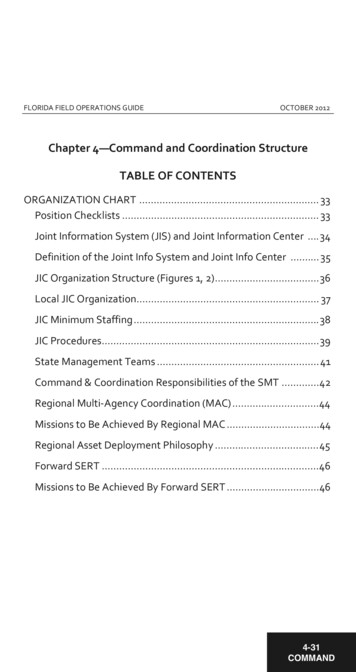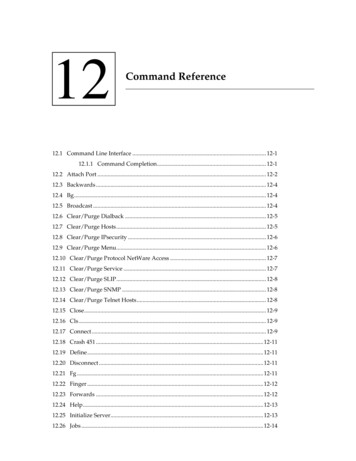
Transcription
FLORIDA FIELD OPERATIONS GUIDEOCTOBER 2012Chapter 4—Command and Coordination StructureTABLE OF CONTENTSORGANIZATION CHART . 33Position Checklists . 33 Joint Information System (JIS) and Joint Information Center . 34 Definition of the Joint Info System and Joint Info Center . 35 JIC Organization Structure (Figures 1, 2). 36 Local JIC Organization. 37 JIC Minimum Staffing . 38 JIC Procedures. 39 State Management Teams . 41 Command & Coordination Responsibilities of the SMT .42 Regional Multi-Agency Coordination (MAC) .44 Missions to Be Achieved By Regional MAC .44 Regional Asset Deployment Philosophy . 45 Forward SERT .46 Missions to Be Achieved By Forward SERT .46 4-31COMMAND
4-32COMMANDFLORIDA FIELD OPERATIONS GUIDEThis page intentionally left blankOCTOBER 2012
FLORIDA FIELD OPERATIONS GUIDEOCTOBER 2012Chapter 4Command and Coordination StructureORGANIZATION CHARTFigure 2 – Organization Chart: Command & CoordinationPosition ChecklistsIncident Commander: The Incident Commander’s responsibility isthe overall management of the incident. On most incidents, a singleIncident Commander carries out the command activity. The IncidentCommander is selected by qualifications and experience.The Incident Commander may have a deputy, who could be fromthe same agency, or from an assisting agency. Deputies may also beused at section and branch levels of the ICS organization. Deputiesmust have the same qualifications as the person for whom theywork, as they must be ready to take over that position at any time.Duties include:4-33COMMAND
4-34COMMANDFLORIDA FIELD OPERATIONS GUIDEa.b.c.d.OCTOBER 2012Review Common Responsibilities (page 2-18).Assess the situation and/or obtain a briefing from the priorIncident Commander.Determine Incident Objectives and strategy.Establish the immediate priorities.Public Information Officer: The Public Information Officer isresponsible for the development and release of information aboutthe incident to the media, incident personnel, and other appropriateagencies and organizations.Only one Public Information Officer will be assigned for eachincident, including incidents operating under Unified Command andmulti-jurisdiction incidents. The Information Officer may haveassistants as necessary, and they may represent agencies orjurisdictions that have a role in the incident.Agencies have different policies and procedures relative to thehandling of public information. The following are the majorresponsibilities of the Public Information Officer, which aregenerally applicable to any incident:a.b.c.d.Review Common Responsibilities (page 2-18).Determine from the Incident Commander if there are anylimits on information release.Develop material for use in media briefings and releases.Obtain Incident Commander’s approval of media releases.Joint Information System (JIS) and JointInformation Center (JIC) Intent and PurposeThe intent and purpose of organizing a JIC is to support impactedcommunities by providing public information to allow them to make
FLORIDA FIELD OPERATIONS GUIDEOCTOBER 2012informed decisions and to avoid unnecessary risks. The guidelinesprovide an organizational process and structure to pre-identifytrained and qualified PIOs from statewide jurisdictions anddisciplines, when requested or directed, may be deployed to supportlocal jurisdictions in their efforts to coordinate press and publicinformation during an emergency. Florida Statute 943 indicates thatthe Florida Department of Law Enforcement has the leadresponsibility for terrorism-based events. In all other events, thelocal EOC provides the Lead PIO.Definition of the Joint Information System (JIS)and Joint Information Center (JIC)The Public Information Joint Information System (JIS) is theorganizational model and process for providing pre and post eventemergency communications support for impacted communities.The system is designed to promote consolidated public informationthrough inter-agency cooperation. Florida is governed by theFlorida Comprehensive Emergency Plan (CEMP), which is comprisedof local governments including the Emergency Operation Centers(EOC), the State EOC, representatives of federal agencies and theseven Regional Domestic Security Task Forces (RDSTF). The JointInformation Center (JIC) is the designated location from whichpublic information is written and distributed. The JIC should beestablished at a location pre-determined by the local jurisdiction(s).Those in the JIC should work closely with the local EOC andliaison(s). The JIC functions best when all components are colocated in a single location. The designated site should be evaluatedto ensure that it is large enough accommodate sufficient staff,telecommunications equipment and computer support. Ifcircumstances prohibit co-location, the JIC components can operate4-35COMMAND
4-36COMMANDFLORIDA FIELD OPERATIONS GUIDEOCTOBER 2012from different physical locations as long as the organizationalintegrity is maintained; operational support is available and thechain-of-command is adhered to.The JIC is responsible for interfacing with the public and mediaand/or with other agencies with incident-related informationrequirements. The JIC develops accurate and complete informationon the incident’s cause, size, and current situation; resourcescommitted; and other matters of general interest for both internaland external communication. The JIC may also perform a key publicinformation-monitoring role.Key elements include the following: Inter-agency coordination and integration Developing and delivering coordinated messages Support for decision-makers Flexibility, modularity, and adaptabilityJIC Organization Structure (Figures 3 & 4)The JIC organizational structure set forth and defined below is therecommended footprint for use by local jurisdictions and RDSTFPublic Information Officers to manage large-scale events orcatastrophic incidents. The structure is scalable and flexible, whichmeans that the functional components contained within the JIC canbe established, as needed, and expanded or contracted to matchthe information needs of the event or incident.The JIC structure works equally well for a local a PIO, EOC, MAC,Area Command or any other coordination entity. Accordingly, thethree organization charts depict JIC structures at various levels ofoperation within the Florida EOC activation system.
FLORIDA FIELD OPERATIONS GUIDEOCTOBER 2012Local jurisdictions that do not possess sufficient number of trainedpersonnel to staff a full function JIC may use resources from otherlocal jurisdictions or request JIC staff support from the County EOC.Local JIC OrganizationNote: JIC can be established using only the components required tosupport the incident.Figure 3 – Local JIC Organization4-37COMMAND
4-38COMMANDFLORIDA FIELD OPERATIONS GUIDEOCTOBER 2012JIC Minimum StaffingFigure 4 – JIC Minimum StaffingEach JIC will consist of representatives of the primary agenciesaffected by the incident, members of the task force and additionalsupport staff deemed necessary depending on the nature of theincident or event. Each JIC will have a designated JIC Manager tosupport the Lead PIO. Pre-designated individuals will be trained tofill key positions from local jurisdictions and each RDSTF.
FLORIDA FIELD OPERATIONS GUIDEOCTOBER 2012The following positions are recommended: Public Information Officer (Local Jurisdiction-Lead PIO forthe JIC)MAC Public Information Officer (RDSTF Liaison to the JIC)JIC ManagerTelephone ManagerRumor Control OfficerCommunity Liaison OfficerGovernment Liaison OfficersContent Experts Coordinator (Chemical, Biological, PublicHealth, Hazardous Devices, etc.)JIC ProceduresEach organization covered by the JIC protocol should developprocedures and specific action-oriented checklists for use duringincident management operations to accomplish its assigned tasks.Procedures are documented and implemented with: Checklists, resource listings, maps, charts, and otherpertinent dataMechanisms for notifying staff and processes for obtainingand using equipment, supplies, and vehiclesMethods of obtaining mutual aidMechanisms for reporting information to organizationalwork centers and onnectivity with private-sector and non-governmentalorganizationsProcedures for the mobilization, staffing, and operation ofa Mobile JIC, if available within the region4-39COMMAND
4-40COMMANDFLORIDA FIELD OPERATIONS GUIDEOCTOBER 2012Liaison Officer: Incidents that are multi-jurisdictional, or haveseveral agencies involved, may require the establishment of theLiaison Officer position on the Command Staff.a.b.c.d.Only one Liaison Officer will be assigned for each incident,including incidents operating under Unified Command andmulti-jurisdiction incidents. The Information Officer mayhave assistants as necessary and they may representagencies or jurisdictions that have a role in the incident.The Liaison Officer is the contact for all representativesassigned to the incident by supporting agencies, outsidethose involved in a Unified Command. Chief responsibilitiesof the Liaison officer include: Identify stakeholders within the affected localgovernment Be a conduit of information between the team and thekey stakeholders.Review Common Responsibilities(page 2-18)Be a contact point for Agency RepresentativesMaintain a list of assisting and cooperating agencies andAgency RepresentativesAgency Representatives: In many multi-jurisdiction incidents, anagency or jurisdiction will send a representative to assist incoordination efforts.An Agency Representative is an individual assigned to an incidentfrom an assisting or cooperating agency who has been delegatedauthority to make decisions on matters affecting that agency’sparticipation at the incident.
FLORIDA FIELD OPERATIONS GUIDEOCTOBER 2012Agency Representatives report to the Liaison Officer or to theIncident Commander in the absence of a Liaison Officer and havethe following responsibilities:a.b.c.d.Review Common Responsibilities (page 2-18).Ensure that all agency resources are properly checked in atthe incident.Obtain briefing from the Liaison Officer or IncidentCommander.Inform assisting or cooperating agency personnel on theincident that the Agency Representative position for thatagency has been filled.Safety Officer: The Safety Officer’s function is to develop andrecommend measures for assuring personnel safety, and to assessand/or anticipate hazardous and unsafe situations.Only one Safety Officer will be assigned for each incident. TheSafety Officer may have assistants as necessary, who may representassisting agencies or jurisdictions. Safety assistants may havespecific responsibilities such as air operations, hazardous materials,etc., and shall:a.b.c.d.e.Review Common Responsibilities (page 2-18).Participate in planning meetings.Identify hazardous situations associated with the incident.Review the Incident Plan for safety implications.Exercise emergency authority to stop and prevent unsafeacts.State Management TeamsThe State Management Team (SMT) is the most common Floridaforward element and serves as the forward coordinating element for4-41COMMAND
4-42COMMANDFLORIDA FIELD OPERATIONS GUIDEOCTOBER 2012the State Emergency Response Team (SERT) and the StateCoordinating Officer (SCO). There are currently five SMT’s withinthe State the SERT Chief can employ. In this role, they will providesituational awareness and operational planning to the SERT and theSCO by incorporating information collected from the StateEmergency Operations Center (SEOC), County EOC’s, localagencies, and SMT reconnaissance. The SMT will also supply allnecessary logistical support to the SERT and SCO for forwarddeployment. Further, the SMT, in coordination with SERT Liaisonsmay be tasked with assisting the State Emergency Response Team(SERT) Chief with other missions as assigned by the SEOC.Missions to Be Achieved By the State Management TeamState Management Teams have six predefined missions they maybe assigned.a.b.c.d.e.f.Support the SERT and the SCO in forward deployment.Provide direct coordination with, and support to assignedSERT liaisons.Support the Recovery process to include the initialcoordination and staffing for the Joint Field Office (JFO).Support the State Logistics Resource Center (SLRC).Provide initial support for a larger forward CoordinatingElement (Forward-SERT).Support for Natural, Technological, and Man-made eventsto include the nuclear power plants.Details for each Mission type can be found in the “Florida SERT–State Management Team Standard Operating Guidelines”Command & Coordination Responsibilities of the SMTa. Think and act strategically in accordance with missiondictates.
FLORIDA FIELD OPERATIONS GUIDEOCTOBER 2012b.Provide clear, strong, and effective communication to theSMT and mission participants.c. Facilitate a collaborative atmosphere.d. Adapt actions and SMT activities to the assigned mission’sneeds.e. Be cognizant of both the current operational needs of themission, as well as event’s political context, local, state, andfederal.f. Delegate authority as necessary in order to accomplish themission.g. Contact SMT members for deployment.h. Implement the assigned SMT Mission, and complete theestablished mission priorities.i. Establish an appropriate SMT Command Post that willmeet both the current mission needs as well as potentialrequirements.j. In accordance with the mission requirements, coordinatethe activities of the SMT with appropriate key officials–local, state, and federal.k. Establish an SMT organizational structure as necessary tosupport the mission, and request additional staffing andassets if required.l. Ensure that the SMT is conducting comprehensive planningin support of the mission requirements. This includes: Conducting reconnaissance in order to developsituational awareness Liaise with other agencies Holding SMT planning meetings, and Develop and approve SMT Incident Action Plan (IAP).m. Review and approve all SMT procurements and requests foradditional assistance.n. In accordance with the assigned tasking, keep the SEOCinformed on both the SMT and mission status.4-43COMMAND
4-44COMMANDFLORIDA FIELD OPERATIONS GUIDEo.p.q.OCTOBER 2012Authorize the release of information to the media insupport of mission tasking.Ensure that the SMT is implementing adequate safetymeasures.Direct the demobilization to the SMT when ordered or themission has been completed.Regional Multi-Agency Coordination (MAC)The mission of Florida’s Regional MAC Groups, though rarely used,is to function as a regional coordination entity to support the localIncident Command in coordination with the County EmergencyOperations Centers (CEOCs) and the SEOC, by assisting with theidentification and deployment prioritization of regional resources, inmulti- county incidents.MAC Groups are all-hazards, multi-discipline, multi-jurisdictionalregional resource-coordinating elements generally comprised ofregional representatives from un-impacted jurisdictions, or firstresponder disciplines whose resources are committed to theincident.When activated, each MAC Group will be organized according to theFlorida Emergency Support Function (ESF) structure and willcoordinate with the CEOCs and the SEOC, to provide resourcecoordination and support within its designated region. MAC Groupswill primarily coordinate the initial emergency services resourceresponse for ESFs 4, 9, 8, 10 and 16, and other ESF assets asassigned.Missions to Be Achieved By Regional MACa. ACTIVATE and operate in support of the incident,
FLORIDA FIELD OPERATIONS GUIDEb.c.d.e.OCTOBER 2012ASSESS the situational impact and need for resources,REPORT situational awareness to the SEOC,COORDINATE the regional response deployment anddemobilization, andDEPLOY regional State assets to augment local resourcesin coordination with CEOCThe MAC Group, in conjunction with local emergency managers, willevaluate available resources in the affected area and coordinate therequest and deployment of in-region assets. If the event exceeds theresources available at the regional level, the MAC Group shallcoordinate requests for additional out-of-region resources with theCEOC and the SEOC. Multi-agency coordination will not supersedethe municipal, county, or state operations plans, nor will it directlocal agency efforts. The MAC Group is NOT designed to replacetactical Incident Command or function as an Incident ManagementTeam (IMT). A MAC may be absorbed by a SMT or FSERT.Details for each Mission type can be found in the “Florida – RegionalMulti-Agency Coordination Group–Standard Operating Guidelines”.Regional Asset Deployment PhilosophyRegional assets will be deployed, as needed, to augment localresponse consistent with direction provided by the State’sComprehensive Emergency Management Plan (CEMP). The MACGroup or Area Command, in conjunction with local EOCs, willmonitor the deployment of local assets or those requested throughMutual Aid in accordance with existing plans.4-45COMMAND
4-46COMMANDFLORIDA FIELD OPERATIONS GUIDEOCTOBER 2012Forward SERTThe Forward State Emergency Response Team (FSERT) serves asthe forward coordination element of the State Emergency ResponseTeam (SERT) under the command of the Deputy State CoordinatingOfficer (SCO). It operates as the State Emergency OperationsCenter (SEOC) under the coordination of the FSERT Chief within thepredefined area of operation with fully delegated authority tomanage all missions and resources on behalf of the SERT. TheFSERT provides resources and technical assistance in support oflocal tactical operations.Missions to Be Achieved By Forward SERTa. Coordinate decision-making support to the impacted localleadership.b. Resources Managementc. Technical Assistance and decision making coordinationd. Situational Awarenesse. Information Coordination.f. Support for Natural, Technological, and Man-made eventsto include the nuclear power plants.The FSERT is the highest-level field coordination element that theState of Florida utilizes. Once assigned an area of operation, theFSERT operates in support of local response operations and doesnot take over command and control of any response operation. TheFSERT will absorb all other coordinating elements operating withinthe area of operations. Details for each Mission type can be found inthe “Florida SERT–Forward SERT Standard Operating Guidelines”.
FLORIDA FIELD OPERATIONS GUIDEOCTOBER 2012Emergency Support FunctionsThe State EOC structure is built around an Emergency SupportFunction (ESF) based system, with ESFs and Branches formed in theICS structure.The following table lists the name and branch of the EmergencySupport Functions in the State Emergency Operations Center.4-47COMMAND
4-48COMMANDFLORIDA FIELD OPERATIONS GUIDEThis page intentionally left blankOCTOBER 2012
JIC Organization Structure (Figures 3 & 4) The JIC organizational structure set forth and defined below is the recommended footprint for use by local jurisdictions and RDSTF Public Information Officers to manage large-scale events or catastrophic incidents. The structure is scalable and flexible, which











